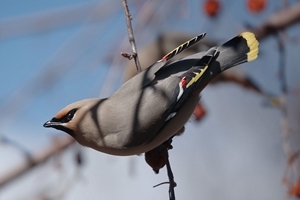Waxwing
 I expect you had your fill of festive quizzes over Christmas, but here is one that might interest you…
I expect you had your fill of festive quizzes over Christmas, but here is one that might interest you…
What bird is plump but is smaller than a starling; has black, yellow and white in the wings; does not breed in the UK but visits in the winter; is pinky-buff in colour; has a grey rump; has a crest; has a small black mask around the eye; and has a bright, yellow-tipped tail? Have you got it yet?
It is none other than the very striking and beautiful waxwing (Bombycilla garrulus). To eliminate confusion as there are two, I will be writing about the Bohemian waxwing, rather than the North American cedar waxwing.
The waxwing is an irruptive visitor from Scandinavia to the UK in the winter months from late October. This means they come over to our shores suddenly in large numbers when the population in their breeding grounds gets too big for the food available, but if food (berries) in Northern Europe is plentiful, few, if any, will move.
This year has been a particular irruption year, with significant numbers of waxwings recorded in the UK since October. The reason for the irruption is said to be the poor berry crops in Finland and Sweden, which have pushed waxwings much further than usual years. And with the bountiful berry year we have had due to late frost, lots of rain, and sun in abundance, these wonderful waxwings have set in, and we have enjoyed the biggest ‘waxwing winter’ irruption for at least a decade!
Massive flocks of over 500 have been recorded in Scotland and the north of England, with sightings filtering down the country to the southern counties since November.
Waxwings are not fussy eaters, but prefer to eat red berries, like rowan berries, to orange berries. They will choose the latter over yellow and white but are not particular about where the trees and bushes grow, as they are quite happy to frequent towns, gardens, parks and car parks. Just before Christmas there was quite a commotion at GWCT HQ, as a colleague had a good sighting of a flock of waxwings in the trees of the nearby Co-op car park in Fordingbridge. When something like that happens so close to home, you see a mass exodus with binos in hand! I even saw them in a car park in the middle of an industrial estate many years ago!
Because the source of their food varies in abundance, waxwings will feast when food is available, sometimes eating double their own bodyweight in berries each day. One bird was recorded eating between 600-1,000 berries in six hours! They pluck fruits from the trees and sometimes eat fallen fruits from the ground. However, with this binging behaviour comes consequences. While the birds can metabolize the alcohol produced by fermenting fruit better than humans, they can still become intoxicated – the Bohemian waxwing less so than the American cedar waxwing, as they have a big liver and can process the alcohol better.
As always, I like to know about where the species name comes from or a bit of mythology surrounding it, and I have found quite a few ideas on the origins of this species’ name:
- Apparently, the waxwing owes its name to the sealing of important letters with red wax, which matches the colour of the striking small red feathers in their wings, making waxwings a symbol of secrecy and trust.
- Other sources say the name comes from the waxy tips to the secondary feathers.
- And another says the Bohemian waxwing specifically gets its name from the wide-ranging movement of winter flocks, playing off the nomadic behaviour of the gypsies of Bohemia.
Whichever is true, I think it is an interesting name – better to have an air of mystery than be too obvious!
As I said, waxwings are just winter visitors, arriving in late October/early November and returning in March to the forests of Fennoscandia to breed. They breed relatively late in May, laying between three and seven eggs in an open-cupped nest, which is incubated by the female for 14 days while the male feeds her.
I will be keeping an eye out for this species over the coming weeks and I hope you will too, and if you don’t get chance to, do tune into Sky Arts to catch up on the delightful programme that was aired over Christmas, Painting Birds with Jim and Nancy Moir – or Vic Reeves as I know him from watching him on TV since I was a teenager. He dedicated the programme to the beautiful waxwing, saying: “They should be the Christmas bird as they are caring, sharing, hang around in family groups and get drunk.”
Megan Lock
Advisory
Image credit: Eddie Carle